This is our bait and fish report for Friday 7/6.
For the second weekend in a row, the Provider went to Catalina last night and made a full load of squid. Our receiver is currently loaded with live squid, really nice sardines, mixed size anchovies and bait sized mackerel. No matter what you're targetting, come by the receiver and we will have the bait you need this weekend. As usual, Martin will be on the receiver all weekend and you can call him on Channel 11 or at (562) 455- 9928. He will be able to give you the lastest bait and fishing information when you talk to him.
The Long Beach Carnage is at Catalina and has full tanks of squid as well. They plan to be there all weekend and have lots of bait, so if you're heading across or you're already across and run out of squid, give Paul a call on Channel 11 or at (562) 714- 8103.
Now to the fish report...
Catalina
The seabass broke wide open again last Friday after I reported that the bite had died off. Well, I am reporting that the bite has died off once again. so let's hope that the seabass rally to prove me wrong again. Just because the big ripper bite on seabass at the squid grounds has ended, doesn't mean that there aren't still plenty of exotics to be caught at the island.
If I were heading across on a private boat this weekend, I would depart at such a time as necessary to get to the island before dawn. The first order of business (of course) would be to pick up some live squid from our receiver or from the Long Beach Carnage at the island. I would run over to the east end and set up for the graylight bite at the squidgrounds outside the V's in 80-100 feet of water. There have still been a few seabass and slug yellows coming out of this area each morning. Please refer to my 6/22 fish report for information on how to effectively fish this area. If the bite doesn't happen (or even if it does), I would start looking again an hour or two after dawn. I would spend the middle of the day hitting up some of the larger reefs and hardbottom areas along the backside from Salta Verde up to the west end. There are quite a few schools of yellowtail cruising around the island right now and the best way to catch them is by having your boat set up at a spot that they are likely to cruise through. When anchoring on these spots, I would avoid anything that sits in less than 40 ft of water or is too thick with kelp as your chances of landing a hooked fish go down significantly in these areas. Once you anchor on the spot, start a chumline of chopped squid. If you don't have enough squid to chunk, you can use a chum bucket (available at most tackle stores). Chum buckets are great because they attract all of the forage fish to your boat which in turn attracts the predatory game fish that you are after. Anyway, when anchoring on these spots, try and find one that has some decent current. You should have several set ups working at these spots. A flylined squid, a squid with a 1/4 to 1/2 oz slider and a heavy jig with a squid on the bottom in a rod holder (you never know when the croaker will make an appearance). 25-30# test is usually sufficient for this type of fishin. I wouldn't go any lighter than 25#, so if you aren't getting bit tie on a fluorocarbon leader.
I would finish up the day at one of the ends of the island (probably the west end for a nicer ride home). Here you would go back to classic seabass fishing. I have given detailed information about how and where to fish in my 6/15 or 6/22 report, so please reference the information there.
The calicos are biting well on the front side of the island and there are still quite a few yellows on that side as well. Most of the spots from the Isthmus to the west end have been biting well, so check out your favorite kelpline or reef. Most of the better scores on yellowtail have come from the areas to the west. The yellows on the front side tend to cruise up and down the island following the deeper ridges that run along the frontside of the island, so remember to check some of the deeper ridges in 70-90 feet of water before anchoring too close to the kelp. If the fish are in the deeper water, you should meter them when you are checking out the spot. If not, they will sometimes find your chumline. The most productive method to catch fish at this time of year is by flylining (sardine, anchovy or squid). If you fish with a sinker, you are going to catch mostly bass, which is a good thing, unless you are targeting yellows.
San Clemente
The big seabass bite has relocated to Clemente there have been fish coming from both the frontside and backside east end of the island. The biggest bite has been on the backside of the island. There are some seabass on the front side of the island as well, but there haven't been the consistent numbers that have been coming from the backside. If you are targeting the seabass at Clemente, it is very similar to targeting them at Catalina. There is no secret information or guaranteed set of numbers that I can give you (regardless of what some people would have you believe). What success breaks down to is; finding areas to fish, trying them out, paying attention to what you see and learning from your experiences.
Here is how to catch seabass in a nutshell...When anchoring, you want to look for structure (hard bottom, a rock, a reef), cover (kelp, off color water) and conditions (current, tidal movement, forage). If you find all of these thing together and there have been seabass in the area, you have a very good chance of getting bit. The yellows have spread out across the frontside of the island with schools of fish cruising along the island in shallow water. If you are heading across and want to target yellowtail, I would suggest starting at the east end and motoring west. Cruise just outside the kelpline and keep your eyes peeled for breezing fish and meter marks. You can also try slow trolling a sardine or mackerel as you cruise up the island. You need squid to catch the seabass, but he yellows seem to be in a transitional mode, prefeing squid over sardines one day and sardines over squid the next. The yellows are also eating the surface iron readily when you first slide up on a breezing school. If you're headed to Clemente, I would take a some squid and some finbait. If you only have the capacity for one or the other, I would take the squid.
Offshore
There have been more and more albacore, with a few bluefin and kelp patty yellows caught in local waters. The majority of the fish this week have come from the 43 and the Butterfly. It's still early in the season and the fish are really starting to stack up out of San Diego, so get ready for some serious offshore fishing this season.
Coastal
The coastal fishing is starting to pick up again!
Palos Verdes Penninsula
The good bass fishing continues, with lots of nice fish (to 6 lbs) being reported. If you do decide to fish these big bass, please keep only what you will eat and try to release any fish over 4 lbs so that it has a chance to spawn and sustain this wonderful fishery.
Your best bet in targeting these bass, is to load up with a scoop of sardines and some smaller anchovies to use as chum. Head up the line and look for areas of cleaner water (doesn't have to be blue, just cleaner than surrounding waters). If you're interested in more information on how to fish this area, check out my report from 6/22.
My friends Jovan Gore and Erik Landesfeind to my advice last week and took some live squid up the line with them. They anchored up at Marineland Reef and had a seabass follow a squid up to the boat and they had some bigger yellows (30 lb +) come up in their chumline. Sadly, the yellows were more interested in the mackerel that were built up on their chum bucket than they were in the hooked baits. After giving it an honest effort, they switched over to calico mode and ended up with limits of calicos from 3 to 6 lbs on sardines and surface iron.
Horseshoe Kelp
The baracuda have made thier triumphant return to the Horseshoe Kelp! If you are interested in targeting the gar, get a tank of sardines and chovies and start looking for birdschools outside of the east end of the breakwall up to Point Fermin.
Izor's Reefs
The bass (sandbass and calicos) have been biting at the Izor's reef as are a few scattered seabass. The bass have been biting the plastics really well, so if you are heading out there, I would suggest taking along a selection of 4-6" swimbaits (key lime has been the most effective color). For more information on fishing the Izor's Reef area, please refer to my report from 6/29.
That's about it for this week.
Now get out there and catch som fish!
See you on the water...
Friday, July 6, 2007
Subscribe to:
Post Comments (Atom)

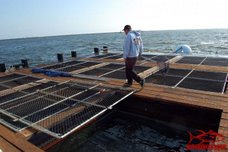
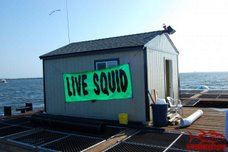
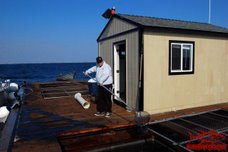
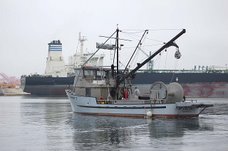
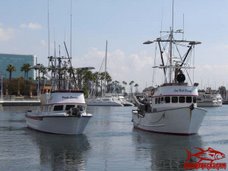
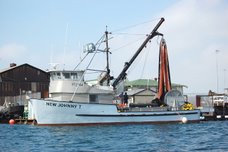
No comments:
Post a Comment